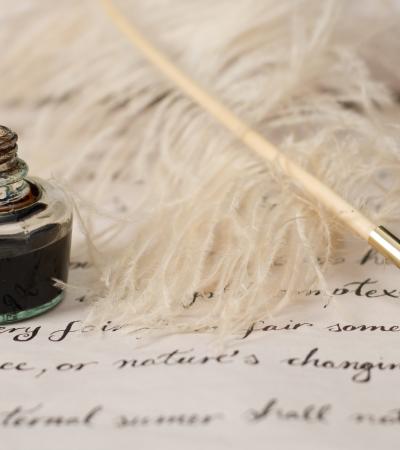The Rockaway Township Public Library, along with our Friends group and other community members, presented a real-life, 19th-century trial reenactment fundraiser. This event, which depicted the trial following the 1882 murder of Benedict Shidecker, brought in 100 attendees and raised over $1,600. Being a smaller library, this was considered a huge success.
We were able to work with our township to use their court/multi-purpose room to increase the number of people that could attend and create a courtroom ambiance that helped bring the re-enactment to life. The audience was prompted to participate at various points throughout the performance, including the selection of 12 audience members to serve as the jury. Our Friends group took over much of the planning of the fundraiser this year, but I will include some information from our previous year’s theater fundraiser, which I was far more involved in planning.
Advanced Planning
An event like this requires a lot of advance planning. Finding creative, talented people to be part of the planning process was absolutely critical to our success. Most of our volunteers came from our Friends group, but we also had members of the community and library staff helping. Even the mayor and chief of police made cameo acting appearances.
When looking for help during our first fundraiser in 2015, I was surprised to find just how many people wanted to be involved. In fact, most of the previous year’s volunteers signed up for this event as well. Our Friends started planning about a year in advance (although five or six months would be workable). They organized most of this year’s event, although I organized most of our first year’s program. I will say that having a number of people that can step up into leadership roles helped me out immensely.
The first step of the process was brainstorming. In 2015, we had a murder mystery dinner theater-type event, and the question was whether to do something similar or try something different. One of our local historians had done some research on trials in the late 1800s and had been considering converting transcripts of an actual trial into a play. He was also willing to write it (our previous year’s play was also written by a local resident). This was a good choice, as it provided local interest and much of the dialogue was already available from transcripts. It was decided that a ticket would cost $15. This was considered inexpensive enough that most people could attend, but still enough that we could hopefully raise a fair amount of money.
The next step was to find people to fill roles; a writer (our historian), actors, organizers and behind-the-scenes folks for things like set-up and costumes. This was not a one-person job! It was determined that the group would meet once a month to discuss updates and new business. The first part of the year focused on ideas. The middle part was when logistics were worked out, such as partnering with the township to use their larger room, determining room layout and placement, and deciding on details (like if refreshments would be served). The last part of the year was spent mostly on rehearsals for the actors and myriad little details. Actors met twice for a read-through, twice for rehearsal and once for a dress rehearsal. A team of three people (and occasionally me) met when necessary to discuss everything from costumes to how we would check people in at the door.
Marketing
Marketing was done through a number of channels. Fliers were put up in the library and other nearby locations. Local newspapers were notified of the event in advance, and a special blurb and picture with the mayor was sent, which most of the papers ran. Social media was used to promote the event as well. View one newspaper's announcement about the event.
However, there were two outlets that best promoted this particular event. First was a special email through Constant Contact, which went to our library's 1,500-person email list. Constant Contact is a pay service, but has done wonders for getting the word out on a variety of things. Finally, word of mouth was our best publicity. Our patrons want to support their library, and this was a fun way to do it.
Budgeting
Our budget consisted of purchasing a few refreshments for the night of the event and some photocopies for fliers, signage, etc. All in all, the cost was less than $50, of which most was paid by our Friends group. Aside from paper and toner, it was free to the library.
Day-of-event Activity
Little set-up was required the day of the event. We needed to rearrange some chairs and bring in a few props and refreshments. Since it was a murder trial and we were holding it in a courtroom, most everything was already how we wanted it; set-up took about 30 minutes. Our first year’s event was a different story. For that, we needed to bring up tables, set table placements, print out seating arrangements and move a few things around. Even so, it was only about 90 minutes of work.
Program Execution
Since a lot of preparation and practice went into the event, the execution of the program went very smoothly. The only difficulty we had was a few people that showed up without registering for the sold-out event. Fortunately, a handful of people didn’t show and we were able to accommodate them, albeit about 15 minutes into the show.
Advice
There are groups in most communities that will put on a theater fundraiser for your library, but they tend to be expensive. I found that this type of event can be done very economically using the people around you. Ask staff, a Friends group, historical society, local government or other community members if they would like to participate.
This is definitely not a one-person job! The first year I took on far too much responsibility and wound up exhausted at the end. Having a number of people involved helps take stress away from the librarian, and you will be surprised at how many people will want to volunteer. However, make sure you keep things organized and running smoothly by checking in with team members regularly.
I would also suggest keeping the topic local, although not necessary. Our patrons loved the fact that we were recreating a real (1800s) local trial, which led to more interaction during the event. Speaking of which, interaction with patrons during the production helps to create an enjoyable atmosphere.
Finally, make sure to provide enough time for planning. I found that a few months was needed to get everyone together for multiple meetings and preparations.
Supporting Materials
- Feedback (Coming Soon!)
- Programming Librarian Facebook Group




